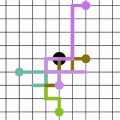The mathematical formulation of constitutive models to describe the path-dependent, i.e., inelastic, behavior of materials is a challenging task and has been a focus in mechanics research for several decades. There have been increased efforts to facilitate or automate this task through data-driven techniques, impelled in particular by the recent revival of neural networks (NNs) in computational mechanics. However, it seems questionable to simply not consider fundamental findings of constitutive modeling originating from the last decades research within NN-based approaches. Herein, we propose a comparative study on different feedforward and recurrent neural network architectures to model inelasticity. Within this study, we divide the models into three basic classes: black box NNs, NNs enforcing physics in a weak form, and NNs enforcing physics in a strong form. Thereby, the first class of networks can learn constitutive relations from data while the underlying physics are completely ignored, whereas the latter two are constructed such that they can account for fundamental physics, where special attention is paid to the second law of thermodynamics in this work. Conventional linear and nonlinear viscoelastic as well as elastoplastic models are used for training data generation and, later on, as reference. After training with random walk time sequences containing information on stress, strain, and, for some models, internal variables, the NN-based models are compared to the reference solution, whereby interpolation and extrapolation are considered. Besides the quality of the stress prediction, the related free energy and dissipation rate are analyzed to evaluate the models. Overall, the presented study enables a clear recording of the advantages and disadvantages of different NN architectures to model inelasticity and gives guidance on how to train and apply these models.
翻译:描述依赖路径(即无弹性)的数学模型的数学构型,即材料的行为是一个具有挑战性的任务,是机械学研究的焦点。我们通过数据驱动技术,特别是最近神经网络在计算机中的恢复而更加努力促进或自动化这项任务。然而,仅仅不考虑过去几十年基于NN方法的研究中形成的构成模型的基本结论,似乎令人怀疑。在这里,我们建议对不同的反馈和经常性神经网络结构结构进行比较研究,以模拟不弹性。在本研究中,我们把模型分为三个基本类别:黑盒 NNIS、NNNNS以弱的形式实施物理,以及NNNF以强的形式实施物理。因此,第一组网络可以从数据中学习构建关系,而基本物理学则被完全忽视,而后两个类的模型可以解释基本物理学,其中对温度动力学的第二法是免费的。在这个工作中, 常规的线性和非线性质量模型使得模型能够将模型分为三个基本结构, 将内线性和非线性结构的模型作为比较性结构, 用来对数据进行分析,这些模型和电算中所使用的数据进行内部压力。</s>





